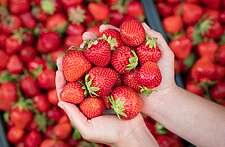In the first two blogs of this series, we explored the flavor trends of frozen desserts in QSR concepts. What we have learned from our research is that the explosion of unique flavors in both the major chains and independents has been growing at a double-digit rate.
New flavors and promotional tie-ins with popular brands or licensees are sales drivers. The life expectancy for many of these novelty flavors may be measured in weeks or months – at most. It keeps product development and marketing departments in a constant state of flavor trend awareness and tight roll-out schedules.
However, North America is a pretty big place! Will a new flavor demonstrate equal success in all markets? Are flavor introductions affected by seasons?
Season by Season
It’s a bit complicated, because here we are talking about menu mentions of flavors as opposed to most popular flavors. Sometimes they are one in the same, and in other cases, the more unique flavors are key differentiators and sales drivers.
Our research shows that regardless of season, there is a core group of flavors that always get menu mentions at frozen dessert QSR establishments. In order, these flavor mentions include Chocolate, Strawberry, Caramel, Pumpkin, Mint, Apple, Vanilla, Peppermint and Coconut. From season to season, the core group may be supplanted by more popular seasonal flavor mentions, but in general, the core group always has a level of demand.
In spring 2013, the top flavor menu mentions for all the leading chains included: Strawberry, Chocolate, Caramel, Coconut, Cookie Dough and Cake Batter; in summer, Apple, Chocolate, Peanut Butter, Black Cherry and Pumpkin. As fall approached, menu mentions most frequently included: Pumpkin, Chocolate, Peppermint, Caramel, Gingerbread and Egg Nog; and with winter came Chocolate, Strawberry, Mint, Caramel and Vanilla. In some cases, the seasonal flavor shifts are logical and expected; for example, we would expect menus to mention Pumpkin and Egg Nog in fall.
Ice Cream
The above referenced menu mentions, but what about regional flavor preferences themselves?
In terms of ice cream and gelato (in general) in 2013, light flavors appealed the most on a national basis when it came to ice cream, as consumers preferred vanilla and strawberry to milk chocolate. However, a flavor developer for a regional ice cream QSR chain or a chain with a strong presence in several regions must be aware that within the aggregate numbers there are many regional variations.
For example, in 2013 across all regions, Fudge averaged an appeal of 62 percent to consumers (that is, the flavor appealed to about 6 out of 10 customers); however in the northeast it fell to 56 percent, while the Midwest showed a climb to 73 percent. Coffee flavor averaged 38 percent overall, but in the Midwest it dropped to 31 percent, while in the west it rose to 48 percent.
Frozen Yogurt
Nationally, in terms of frozen yogurts, fruit flavors, especially strawberry, peach and berry, were preferred among consumers for yogurt and frozen yogurt desserts.
While regional frozen yogurt differences can be seen in flavor preferences, they typically don’t have as dramatic a fluctuation as ice cream though there are some exceptions. For example, Banana flavored yogurt appealed to 56 percent of consumers in the Northeast, but dropped to 43 percent with Western Consumers.
Interestingly, a real specialty flavor in either ice cream or yogurt usually doesn’t do well across the board! We are not talking about Pumpkin flavors around Thanksgiving, rather exotic ingredients such as Lavender or Lychee that barely cracked the 10 percent appeal level regardless of region!
The development of new flavors in the category is a complex business. Product developers need to not only track regional flavor preferences but pull in flavor experiences relating to a wide-reaching group of trends.





